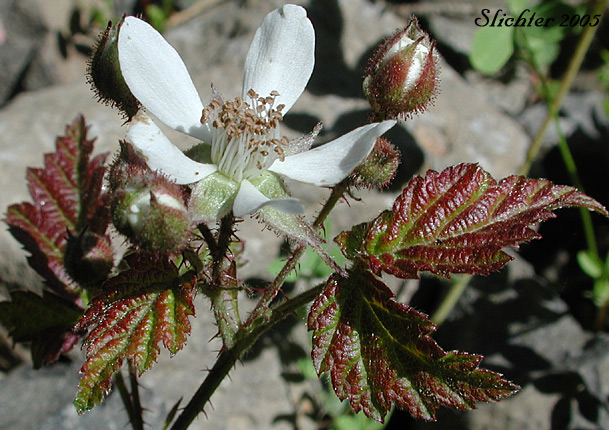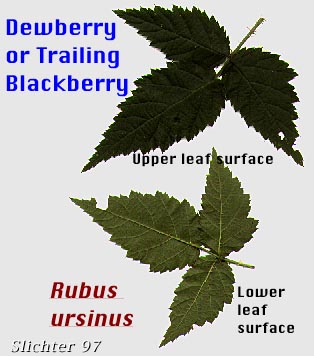

 Characteristics:
Characteristics:
Trailing blackberry or dewberry is a slender, single, trailing or climbing viny stem up to 6 meters in length when found in shady sites, or may exist as a multiple stemmed plant forming dense tangles in open areas. The stems are covered with a fine, waxy powder, covered with small, sharply recurved, hooked spines, and varies in color from light green to green. Erect, leafy side branches form within the second year and bear at their terminus the flowers.
The leaves are alternate on the stems. They are ternately compound, or have 3 leaflets which are green above and a pale white-green below with prickles on the petioles and major veins. The leaflets are roughly triangular in shape with coarsely toothed margins. The terminal leaflet is larger, ranging up to 3-7 cm in length. It is often 3-lobed.
The 5-petaled flowers are white and are either male or female. The male flowers have narrowly elliptic to elliptic-spatulate petals from 12-18 mm long with 75-100 stamens. The female flowers have wider petals (sometimes oval) ranging from 8-12 mm in length and with numerous pistils. The fruit is an elongated blackberry up to 2.5 cm long and about 1 cm thick.
The trailing blackberry is our native blackberry and it produces fruit of excellent flavor. It has been the source of a number of our commercial blackberries, including boysenberry, loganberry and the mammoth berry. In the woodland garden however, it may be hard to control its growth (it's not as prolific in its spread as the Himalayan blackberry). The fruit is highly prized by humans for its firmness and sweet flavor. It is a valuable food source for many birds and mammals.
Dewberry may be found in open to dense foods as well as on prairies, clearings, or logged and disturbed sites from sea level to moderate elevations in the mountains..
Dewberry may be found from British Columbia south to northern California and east to central Idaho.
It may be found in the Columbia River Gorge between the elevations of 100'-4900' from the western entrance to the gorge to as far east as Major Creek.